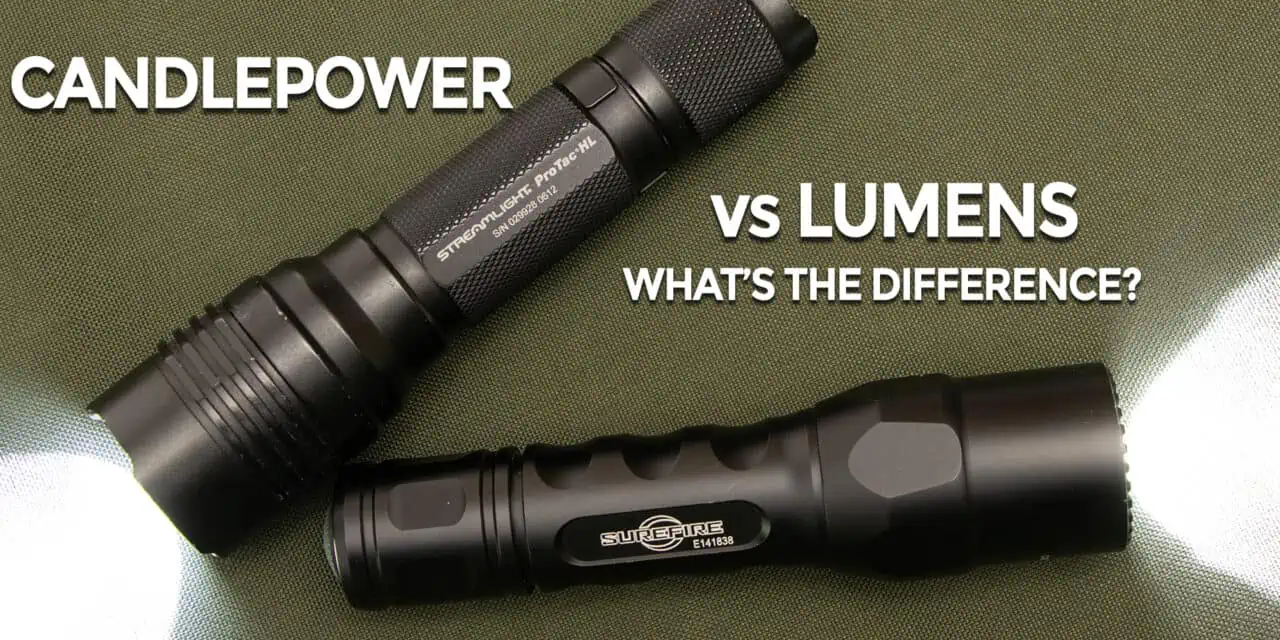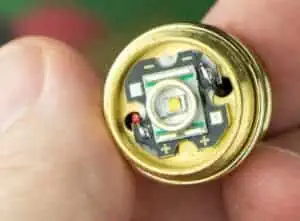Candlepower vs Lumens – It’s Not a Competition
Ever look at a flashlight advertisement and try to figure out if one light is brighter than another? One ad might state the flashlight has 38,000 candlepower of light while another company’s torch boasts 600 lumens. In this battle of candlepower vs lumens, which is brighter?
Unfortunately, many flashlight companies use selected specifications to confuse consumers. So, how can you tell which flashlight is brightest?
In my previous article, I explained the basics of peak beam intensity and total light output. In this article, I will explain:
- what light output (lumens) is,
- what peak beam intensity (candlepower or candelas) is,
- how to understand candlepower and lumen ratings, and
- why all of it matters.
Light Output
A flashlight uses a bulb or LED to create light and a reflector to direct the light in a specific direction. We call the amount of light the source creates light output. It’s measured in lumens.
Light output is not affected by the reflector or direction of the light. Rather, it is the sum total of all of the light emitted in all directions.
Think about a bare 100-watt light bulb hanging from the ceiling of a room. That bulb emits light in all directions: up, down, and 360˚ around. All of the light coming out of the bulb is its light output. Each unit of light output is a single lumen. The amount of light the bulb emits could be hundreds or thousands of lumens.
Peak Beam Intensity
Peak beam intensity is related to light output but describes a different aspect of the light’s characteristics.
If you were to put a reflector on one side of the bare bulb described above, the light would be intensified in one direction. The light output hasn’t changed – only the direction it is focused.
We measure peak beam intensity at the center of the beam created by the reflector. We express it in candlepower or candelas. You can use the term candela interchangeably with candlepower, though they are not equal. Rather, 1 candlepower is equal to 0.981 candelas. Consumers frequently use candlepower, while labs use candela when reporting specifications according to the FL1 standard. Marketers can use either in flashlight advertising.
When you read the manufacturer specifications on a flashlight, remember that lumens measure the total output while candlepower measures the brightness of the directed beam.
Cooperative Relationship of Candlepower vs Lumens
From a historical perspective, some flashlight companies marketed their lights based on lumen output while others touted high candlepower. Without plainly stating it, companies created a false dichotomy of lumens vs candlepower. This led to a great deal of confusion for consumers when looking at Brand X Flashlight with 200 lumens and Brand Y Flashlight with 25,000 candelas. Neither company was telling the whole story.
The relationship of candelas to lumens can suggest how focused the flashlight’s beam is. For example, a flashlight with a light output of 200 lumens and a peak beam intensity of 25,000 candlepower would have a more focused beam than a 200-lumen light with a peak beam intensity of 12,000 candlepower.
Likewise, a flashlight with 500 lumens and 15,000 candlepower will have a wider throw than a light rated for 200 lumens and 15,000 candlepower.
Having a highly focused beam allows you to illuminate objects at greater distances while having less of a flood effect. How focused you want your flashlight will vary based on your use. A wide flood pattern might better serve a police officer searching the inside of a building. Yet the same officer will likely prefer something with a tighter beam when searching a golf course where the distances may be 100 yards or more.
Beam Distance: Another Measurement to Consider
In addition to candlepower and lumens, manufacturers will often include a beam distance measurement. We typically present this measurement in meters.
The beam distance is the length of the flashlight’s light projection until it falls below a brightness of 0.25 lux. The brightness of a full moon at night is roughly equal to 0.25 lux.
If a manufacturer listed a beam distance of 500 meters, this means on a moonless night you would be able to see something at 500 meters when using the flashlight with the same clarity as if you had no flashlight but there was a full moon overhead.
In many cases, that level of brightness is not adequate for properly identifying a threat. However, you can use the measurement to compare two flashlights to gain a greater understanding of how each throws light. When you mix in light output and peak beam intensity, you should get a reasonable idea of what the flashlight’s beam pattern will look like without ever turning one on.
Manufacturer Clarity
As I suggested in my earlier article, The Ins and Outs of Tactical Flashlights, flashlight marketing can be misleading. Some of the less reputable companies wildly inflate output numbers and run time. This is why it is so important that companies adhere to the FL1 standards. The standards are not perfect, but at least you can be reasonably sure that the reported numbers are accurate.
Even so, some of the best companies elect not to publish important data about their products. For example, SureFire states it tests some its products to the deprecated FL1 (2009) standard. Even so, I rarely see peak beam intensity measurements (candelas) listed in any advertising materials for the company’s lights.
In a case where lumens are listed but candlepower or candelas are not, you can try comparing beam distances. Since beam distances are related to candlepower, a longer beam distance will suggest a higher peak beam intensity. It is not a perfect substitute, but it can help you make an informed decision.
When you are comparing tactical flashlights, try to ensure that the companies are listing specifications tested to the same standard. If the marketing materials are unclear as to what standard the flashlights have been tested, you can reach out to the customer service department for additional information. This will give you the best opportunity to truly compare apples to apples.
Final Thoughts
Not understanding the differences between candlepower and lumens can lead you to make a poor choice in a self-defense flashlight. Fortunately, it is easy to learn what each unit measures.
An ongoing problem is getting all flashlight manufacturers to test to the same standard and to have them clearly publish that data on each light. That is much harder to accomplish and requires greater consumer pressure for increased transparency.
Another area of misunderstanding is on run time: how long a flashlight will produce light on a single set of batteries. Believe it or not, this is an area companies can significantly game even when they comply with the FL1 standard. We’ll go deeper into run time in my next flashlight article.




